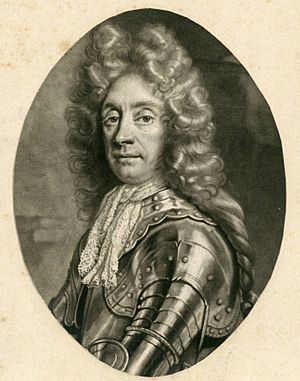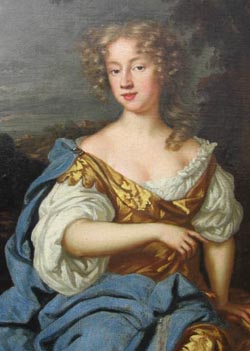Thomas Maxwell (Jacobite) facts for kids
Quick facts for kids
Thomas Maxwell
|
|
|---|---|

Thomas Maxwell, c.1692, after portrait by Closterman
|
|
| Born | Nithsdale, Scotland |
| Died | 1693 Marsaglia, Piedmont |
| Allegiance | |
| Years of service | 1671-1693 |
| Rank | Major General |
| Battles/wars | Williamite War in Ireland: Nine Years War |
Thomas Maxwell (died 1693) was a Scottish soldier who served as an officer in the army. He spent much of his career with the English and Irish Royal Army. During the Williamite War in Ireland, he stayed loyal to King James II. After the war, he joined the French army and was later killed in battle.
Contents
Life of Thomas Maxwell
Early Years
We don't know much about where Thomas Maxwell came from. His family was part of a small group of Roman Catholics in Scotland. He went to a school called the Scots College, Douai in 1662. Then, in 1664, he moved to another school, the Royal Scots College in Madrid.
Joining the Army
Even though being Catholic limited his career choices, Maxwell joined the army in 1671. When James II, who was also Catholic, became king, Maxwell's career got better. He became a close helper of the Earl of Melfort, who was a friend of the King. In 1688, Maxwell became a colonel in a group of soldiers called the Princess Anne of Denmark's Regiment of Dragoons.
While he was working in England, he married Jane Howard, Duchess of Norfolk. There are also some old pictures of Maxwell that were made from a painting by Closterman.
The Williamite War in Ireland
Staying Loyal to King James
In late 1688, there was a big change in England called the Glorious Revolution. King James II was replaced by his Protestant son-in-law, William. Thomas Maxwell was one of the officers who stayed loyal to King James. He traveled to Ireland, where King James still had control of the army. There, Maxwell was put in charge of the Seventh Regiment of dragoons. He was in Bangor, in eastern Ulster, when William's army landed in 1689.
Important Battles
During the war, Maxwell was at the Battle of the Boyne, where King James's army lost. He became one of six major-generals for King James. He was also chosen to help advise King James's son, the Duke of Berwick, who led the army later in 1690.
Maxwell and Berwick wanted to try and make peace to end the fighting. But other leaders, like Patrick Sarsfield, wanted to keep fighting. When Sarsfield's friends went to France to ask for help, Maxwell was sent with them. He had secret orders to have them arrested when they arrived. But they found out about the plan during the trip.
In 1691, Maxwell was in charge of defending Athlone when William's army attacked it. His dragoons bravely defended the bridge over the River Shannon. He was captured when the city was taken. Some people unfairly blamed Maxwell for the loss because he had wanted to make peace.
Maxwell was sent to the Tower of London with other captured leaders. The war finally ended in October when King James's main army gave up at Limerick.
Later Life and Passing
After he was set free in January 1693, Maxwell joined the rest of King James's army. This army had joined the French service as part of a peace agreement called the Treaty of Limerick. Sadly, Thomas Maxwell was killed in battle at the Battle of Marsaglia in October of that same year.


